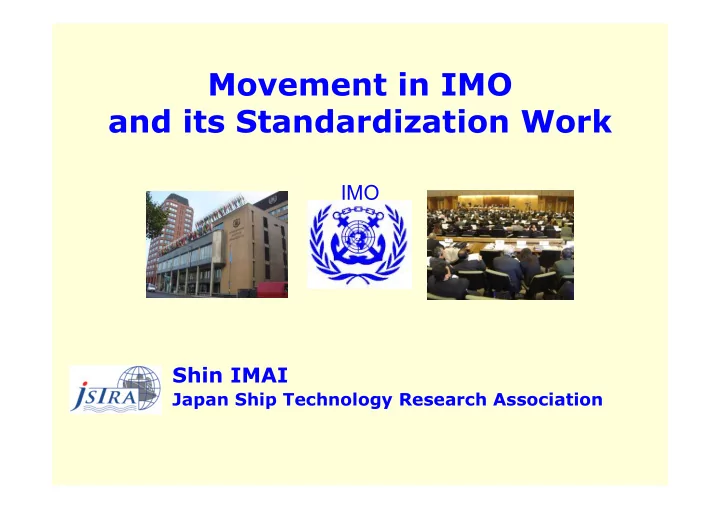

Movement in IMO and its Standardization Work IMO Shin IMAI Japan Ship Technology Research Association
Outline of the presentation 1. History of Performance Standard for Protective Coating (PSPC) 2. Working Plan of IMO 3. Recent developments and future issues for corrosion prevention at IMO 1. Dedicated Sea Water Ballast Tank and Double Side Skin Spaces (SWBT/DSSS) 2. Void Spaces (VS) 3. Cargo Oil Tanks (COT) 4. Standardizations of new technologies at IMO
1. History of PSPC at IMO 1995 Nov IMO adopted Resolution A.798(19) " Guidelines for the Selection, Application and Maintenance of Corrosion Prevention Systems of Dedicated SWBT ”. 1996 Jun MSC66 adopted mandatory SOLAS requirement of corrosion prevention system to SWBT in oil tankers and bulk carriers. 1997 Nakhodka 1997 Nakhodka 1999 Erika 1999 Erika
1. History of PSPC at IMO (cont.) 2000 Tanker Structure Co-operative Forum (TSCF) developed “ Guidelines for Ballast Tank Coatings Systems and Surface Preparation ” 2002 Prestige 2002 Prestige 2002 Dec MSC76 agreed to develop mandatory PSPC and instructed DE Sub-Committee. 2004 Dec MSC79 adopted mandatory SOLAS requirement of coating in DSSS and SWBT in bulk carriers of 150m in length and upwards. 2005 Feb IACS-JWG submitted a proposal to DE48 based on TSCF ( 15 years ) and A.798(19).
2. Working Plan of IMO 2005 2006 2007 2008 2009 MSC MSC MSC MSC MSC MSC DE DE DE DE DE 80 81 82 83 84 85 48 49 50 51 52 2002- Seawater Ballast Tanks and Double Side Skin Spaces Void Spaces PMA Maintenance Cargo Oil Tanks
3.1 SWBT/DSSS • In Dec 2006, MSC82 finally adopted PSPC for SWBT/DSSS and SOLAS requirements throughout substantial arguments and compromises. – It will apply it to ships contracted on or after 1 Jul 2008. – IACS already applied to bulkers(L>90m) and tankers and contracted on or after 8 Dec 2006. • However, there were a number of items that need clarifications or interpretations for uniform application, and it concerned the industries. – Sampling inspection method at automated shop-primer facilities. – Assistances to the coating inspectors. (The Standard requires tremendous number of coating thickness measurement.) – etc.
3.1 SWBT/DSSS (cont.) • JWG, consisting Shipowners, builders, coating manufactures, was established by IACS in May 2007 and started developing Guideline for Implementation. – Unanimously agreed issues were incorporated in the Guideline, and the draft was finalized in Aug 2007. – It will be reported to the Tripartite Meeting in September and expected to be forwarded to IMO as information paper. • Shipbuilders are still concerned about the requirement of Soluble salt limit and seeking solution in terms of interpretation as well as practicability.
3.2 Void Spaces (VS) • DE50 (Mar 2007) developed draft PSPC for VS. – Lower coating specification than that of SWBT. – PSPC for SWBT applies to some important VS. – “totally enclosed space” are excluded from application because of impracticability. SWBT Void Space • MSC83 (Oct 2007) will finalize the PSPC for VS. Main issues will be: – Should it be Mandatory or recommendatory standard? – How many spray coats should be required, one or two? – Is “totally enclosed spaces” allowed to exist under SOLAS? – What coating standard should apply to such spaces?
3.3 Cargo Oil Tanks (COT) • Upon the recommendation of EMSA in 2005, IACS/JWG have been developing PSPC for COT of oil tankers. • At MSC82 in Dec 2006, twenty one European countries, IACS and NGOs jointly proposed a mandatory requirement of coating to COT of tankers. • Japan proposed “anti-corrosion steel” and its performance standard (PS) as an alternative option to protective coating, since such effective steels have already been developed and considered to be beneficial. • DE and its Correspondence Group (CG) are dealing the issue with a target completion year of 2009. • Main issues are: – Should “ant-corrosion steel” be specified in SOLAS with a PS like coating or treated as one of the “alternatives”? – What PS, including testing and verification, should be applied for COT?
4.Standardizations of new technologies CONCERNS: • How can new technologies/methods be proved to be equivalent or effective enough? • Do IMO regulations allow field testing of new technologies that has not yet proved to be equivalently effective? • Do we have to wait for many years to gain experiences and justifications (e.g. 15 years to judge that it is equivalent to coating)? • How many years does IMO needs to amend or develop regulations and standards?
SOLAS basic provision for alternatives SOLAS Chapter I: General provisions Regulation 5 Equivalents (a) Where the present regulations require that a particular fitting, material, appliance or apparatus, or type thereof, shall be fitted or carried in a ship, or that any particular provision shall be made, the Administration may allow any other fitting, material, appliance or apparatus, or type thereof, to be fitted or carried, or any other if it is provision to be made in that ship, satisfied by trial thereof or otherwise that such fitting, material, appliance or apparatus, or type thereof, or provision, is at least as effective as that required by the present regulations .
Some hope, suggestions and requests • To achieve sustainable safety improvement and environment protection, IMO technical regulations should – not discourage/impede R&D. – not be too prescriptive. Should be more goal based. – allow exemption of requirements for challenging/testing. • To enable IMO to make correct and practical decision on technical matters, – Naval architects and industries and should be more informed of the latest movements and discussions in IMO. – Scientific inputs should be forwarded to the regulatory bodies and IMO more actively. – Naval architects and industries should strengthen their voice within each country as well as to the IMO directly.
Thank you.
Recommend
More recommend